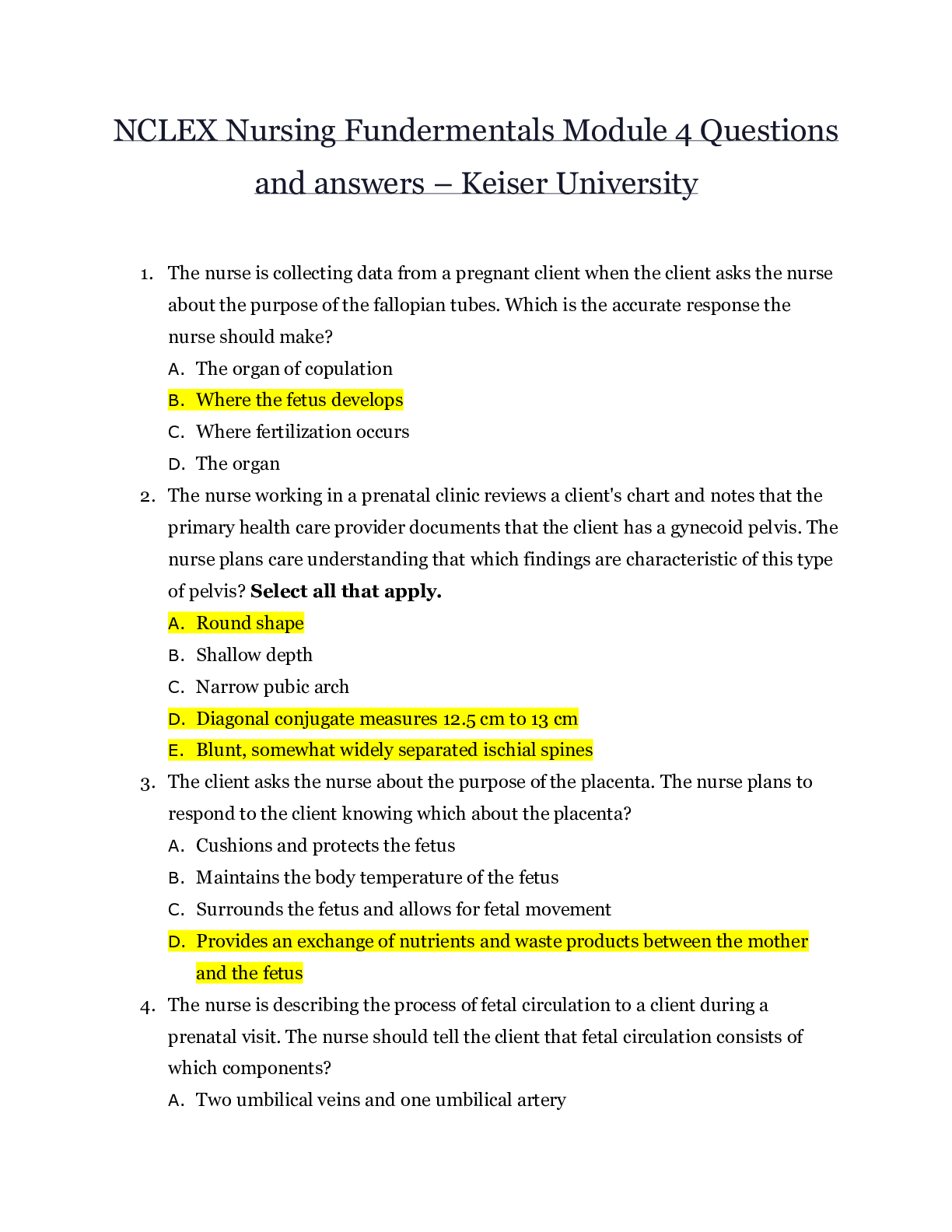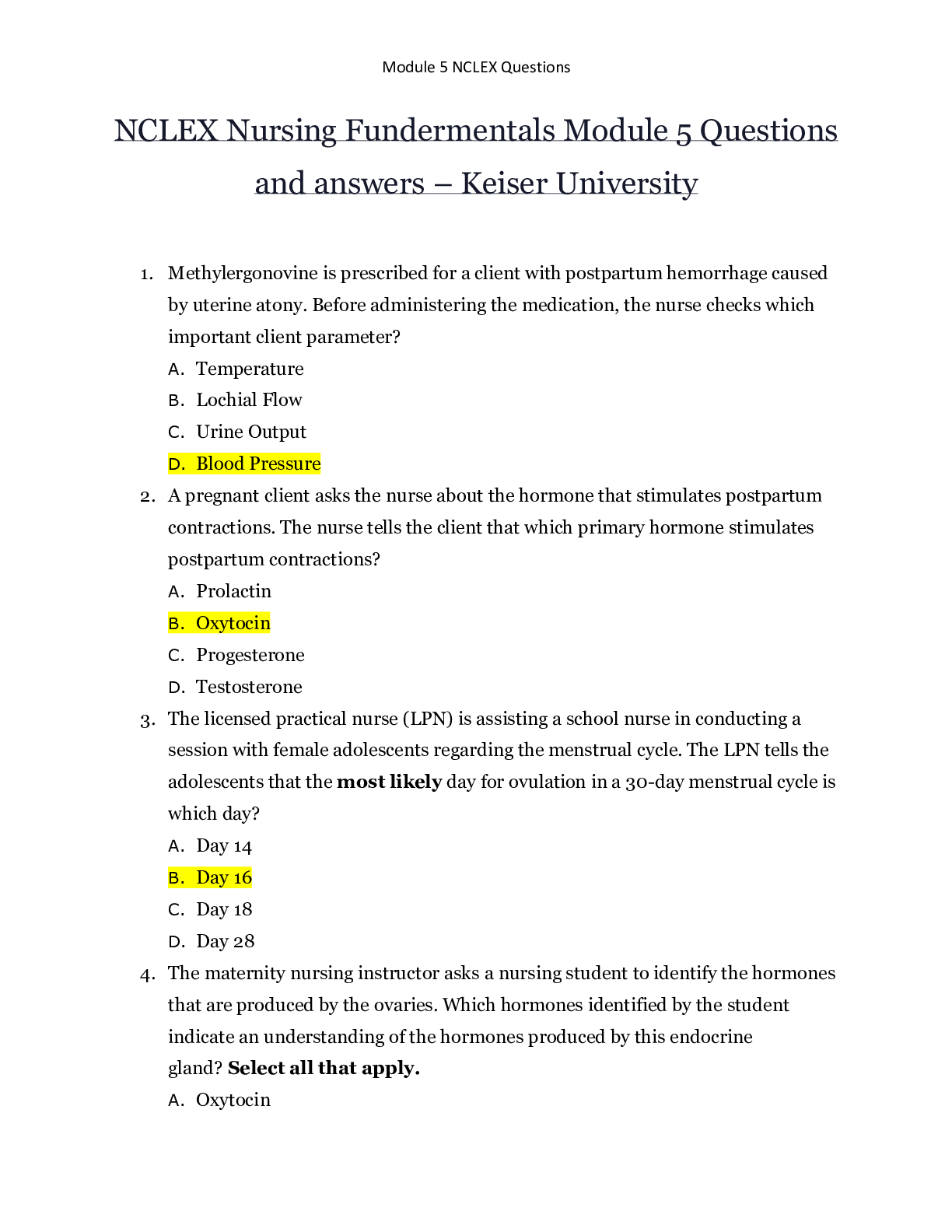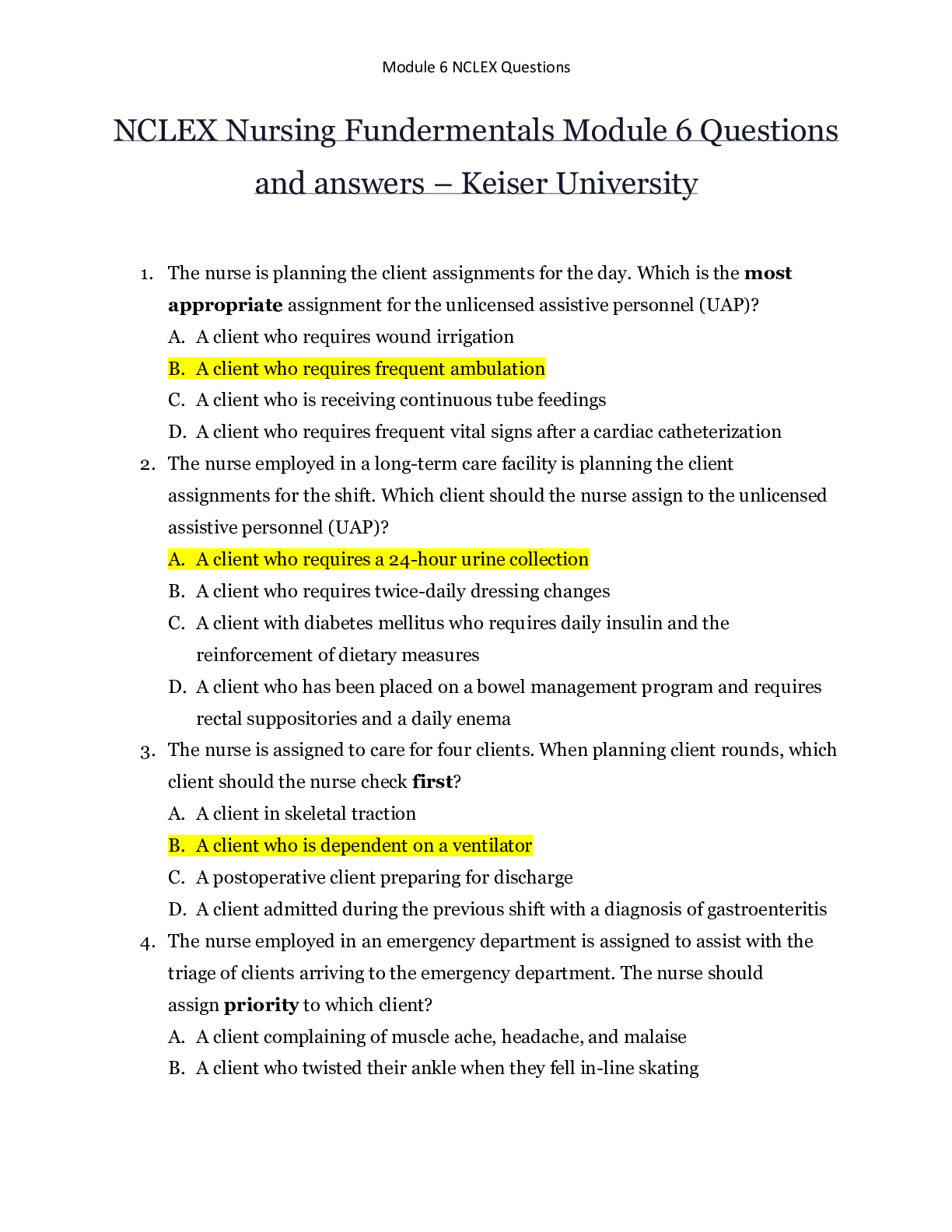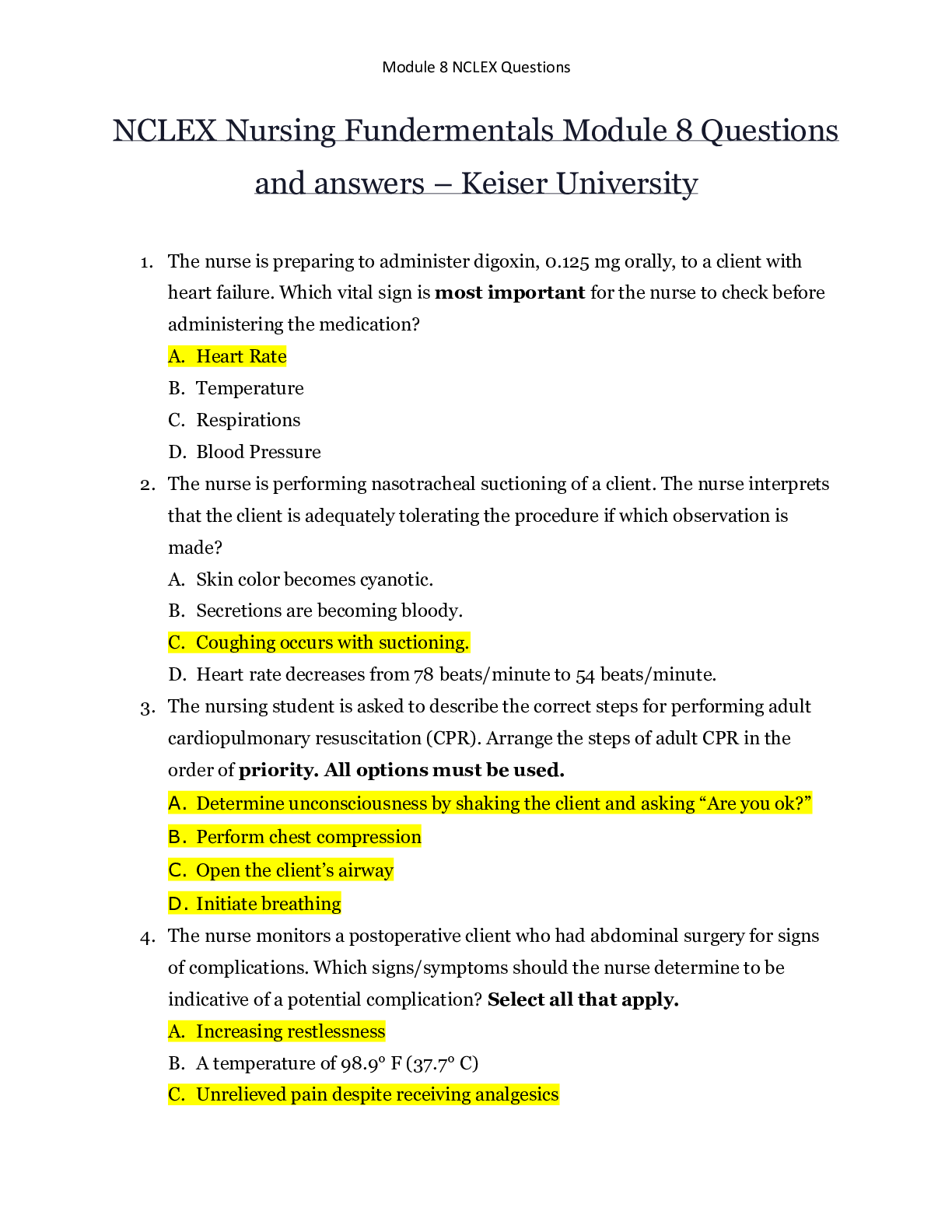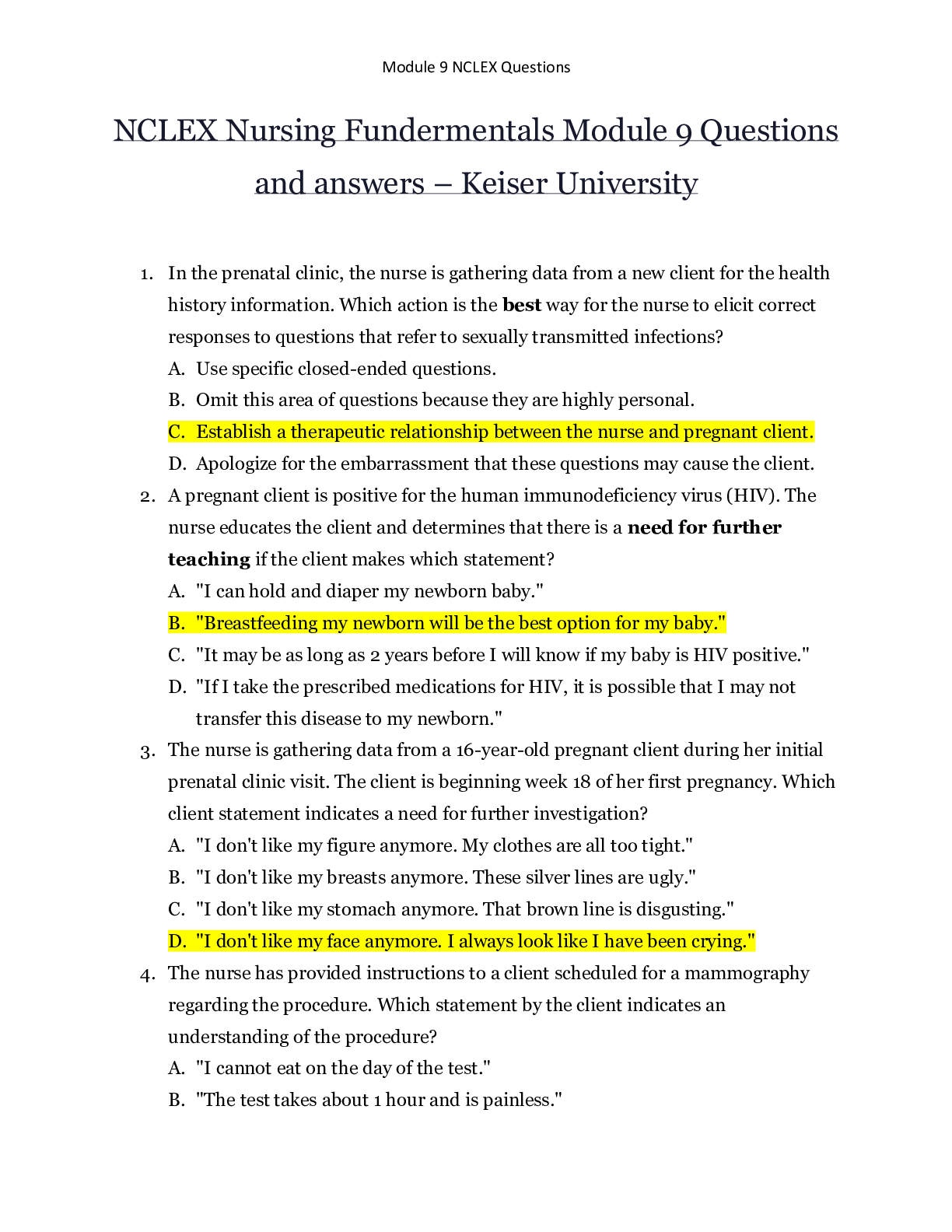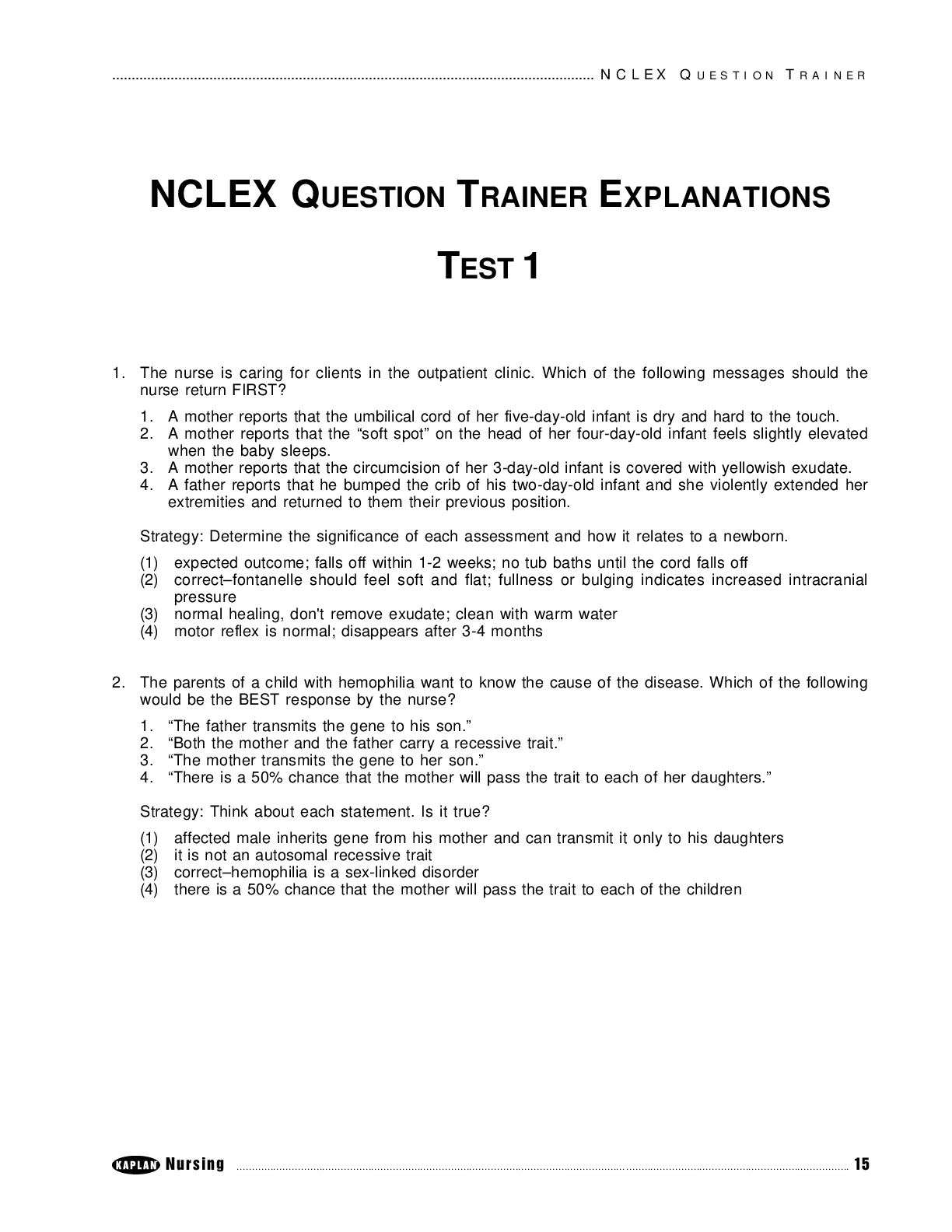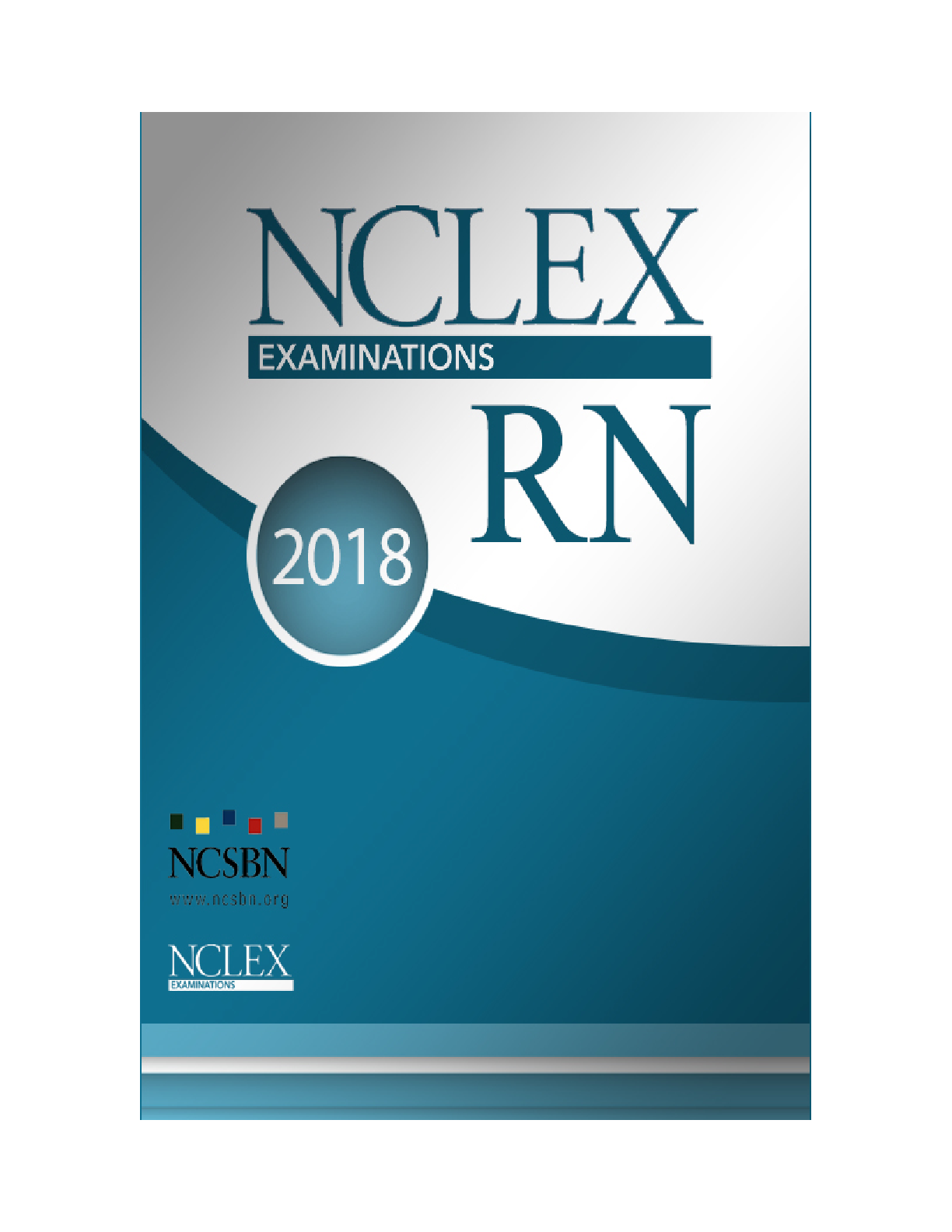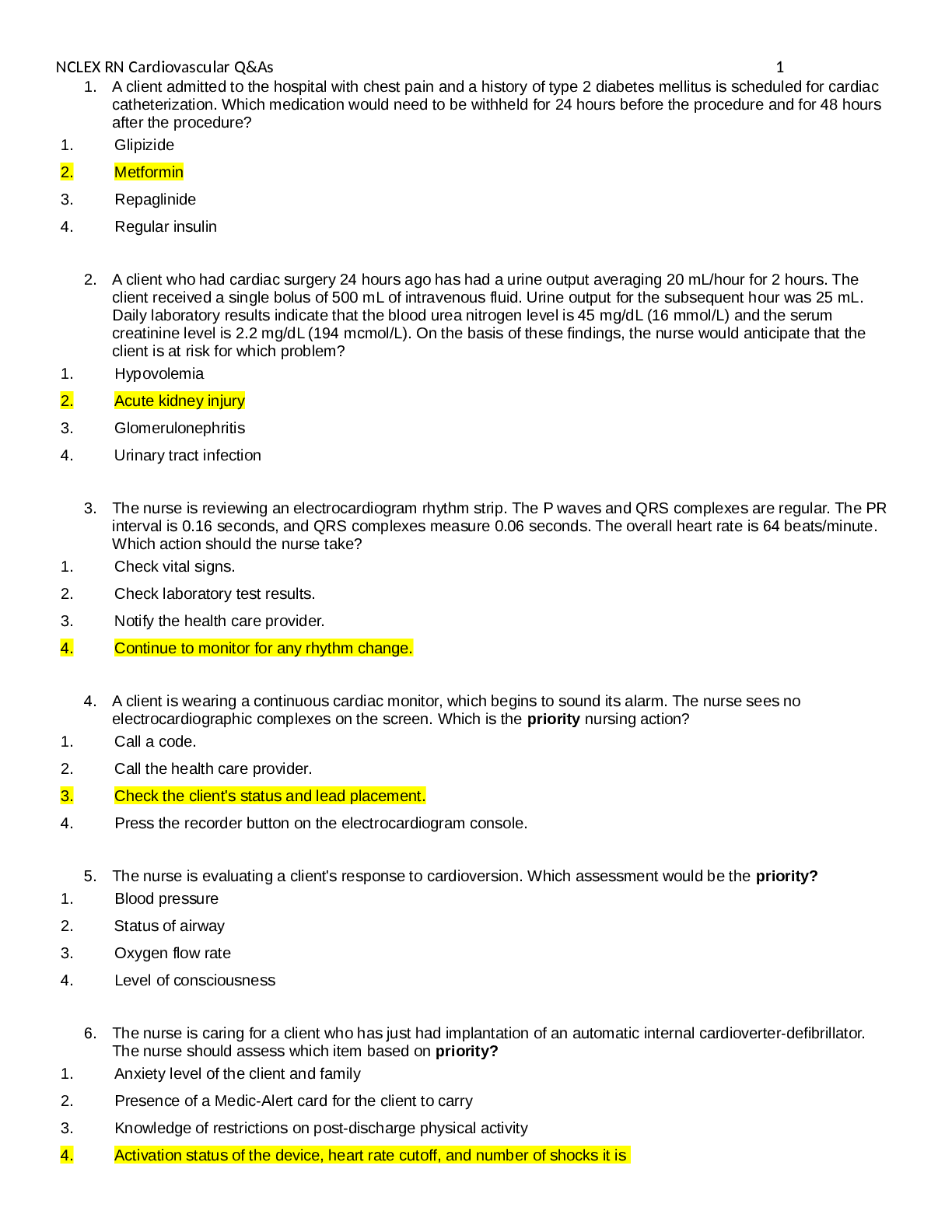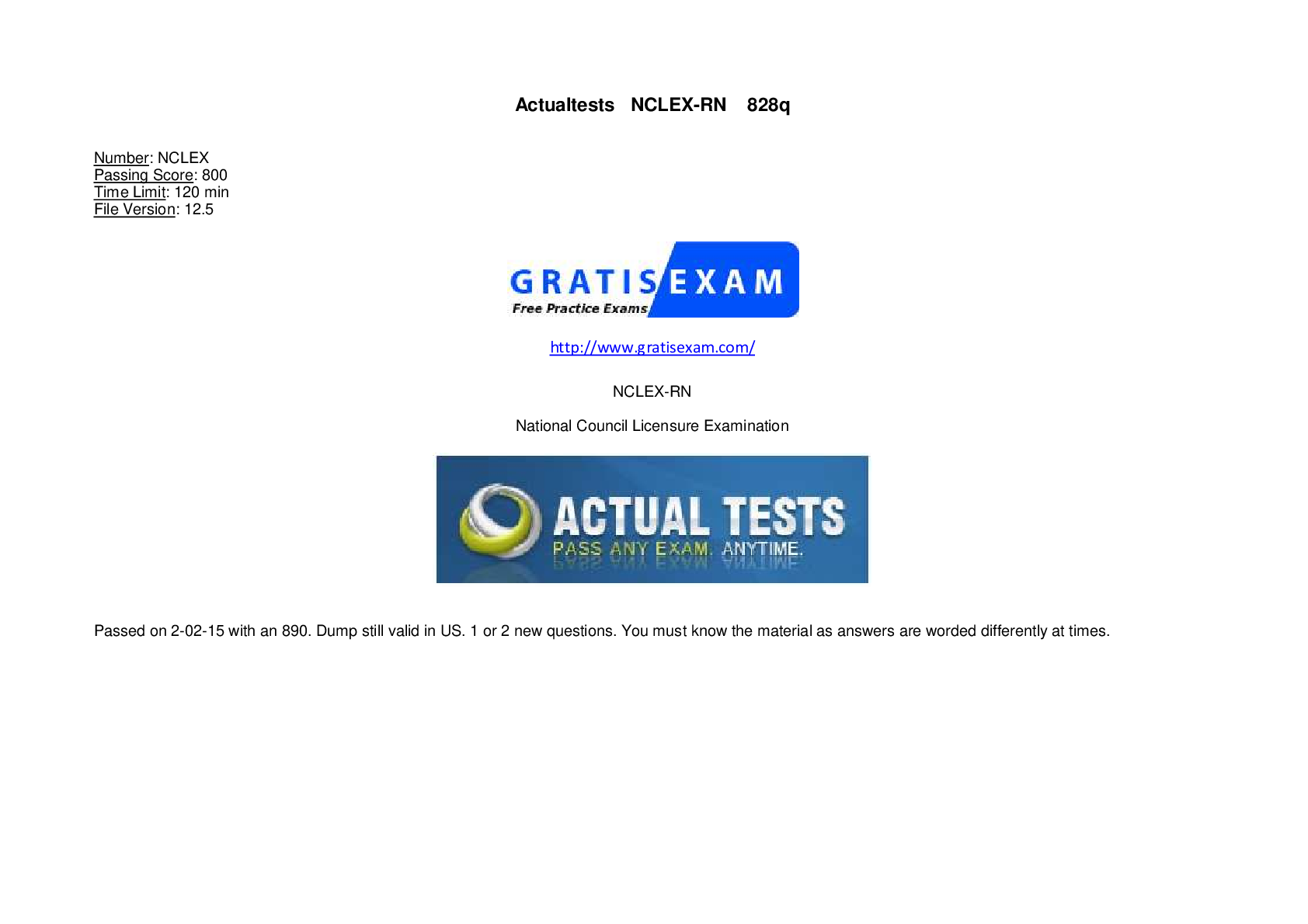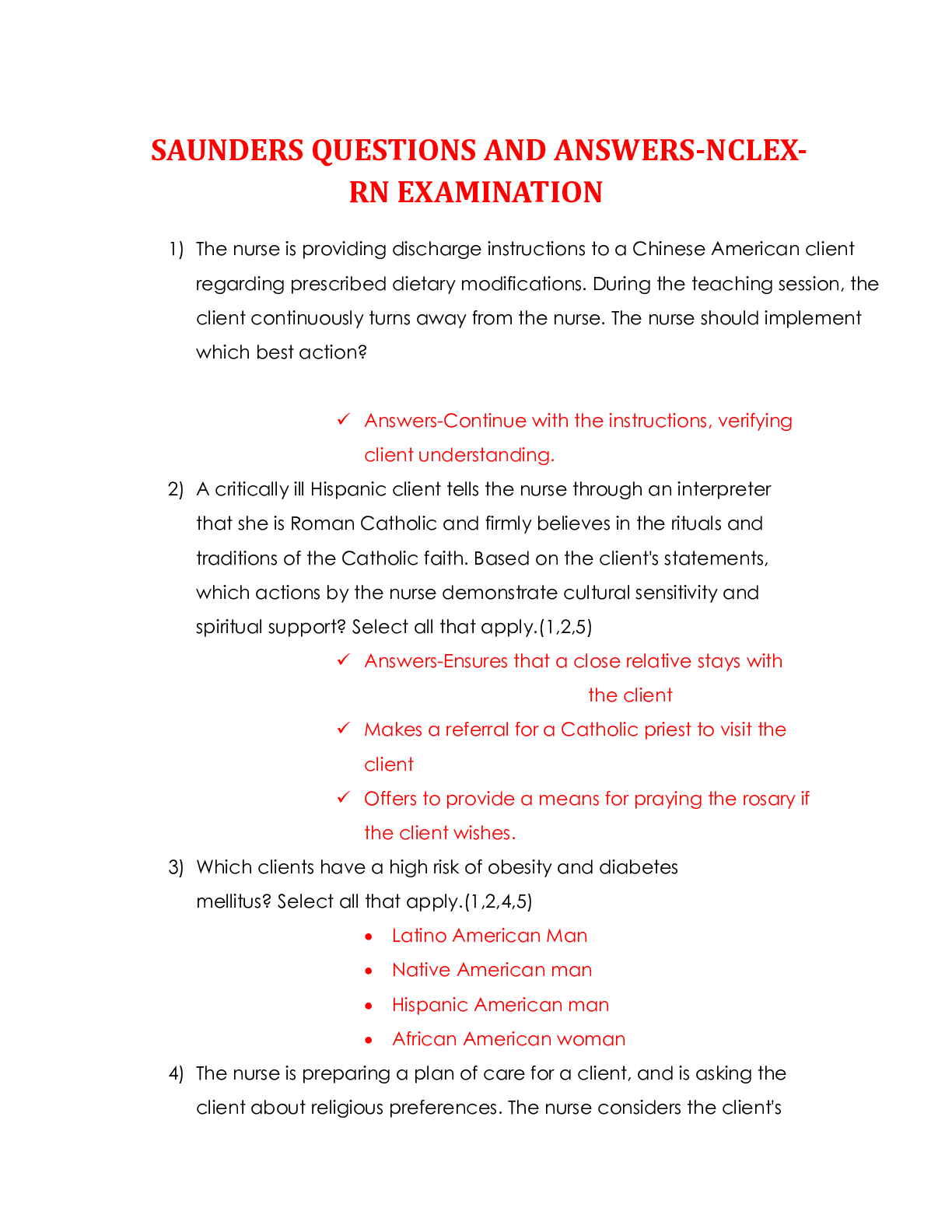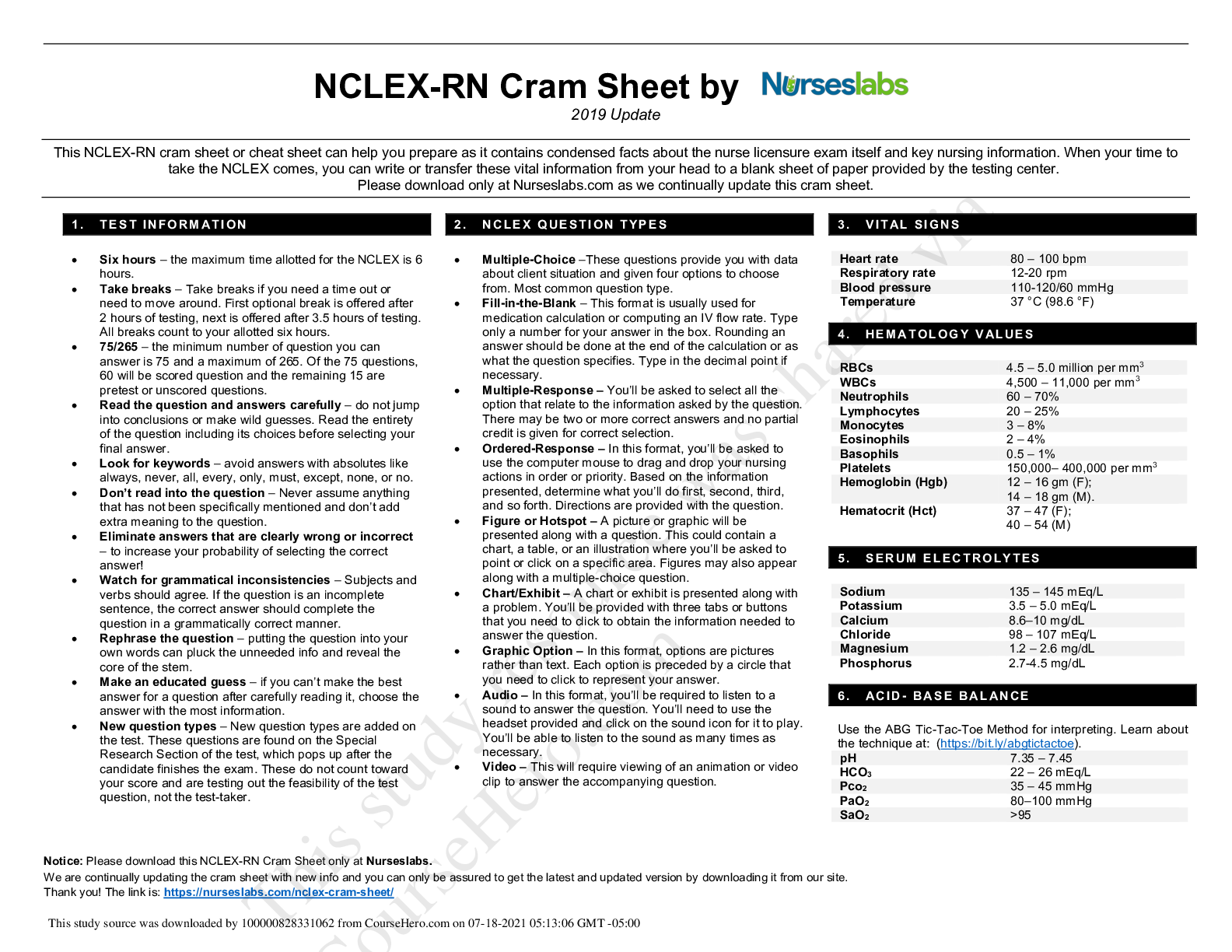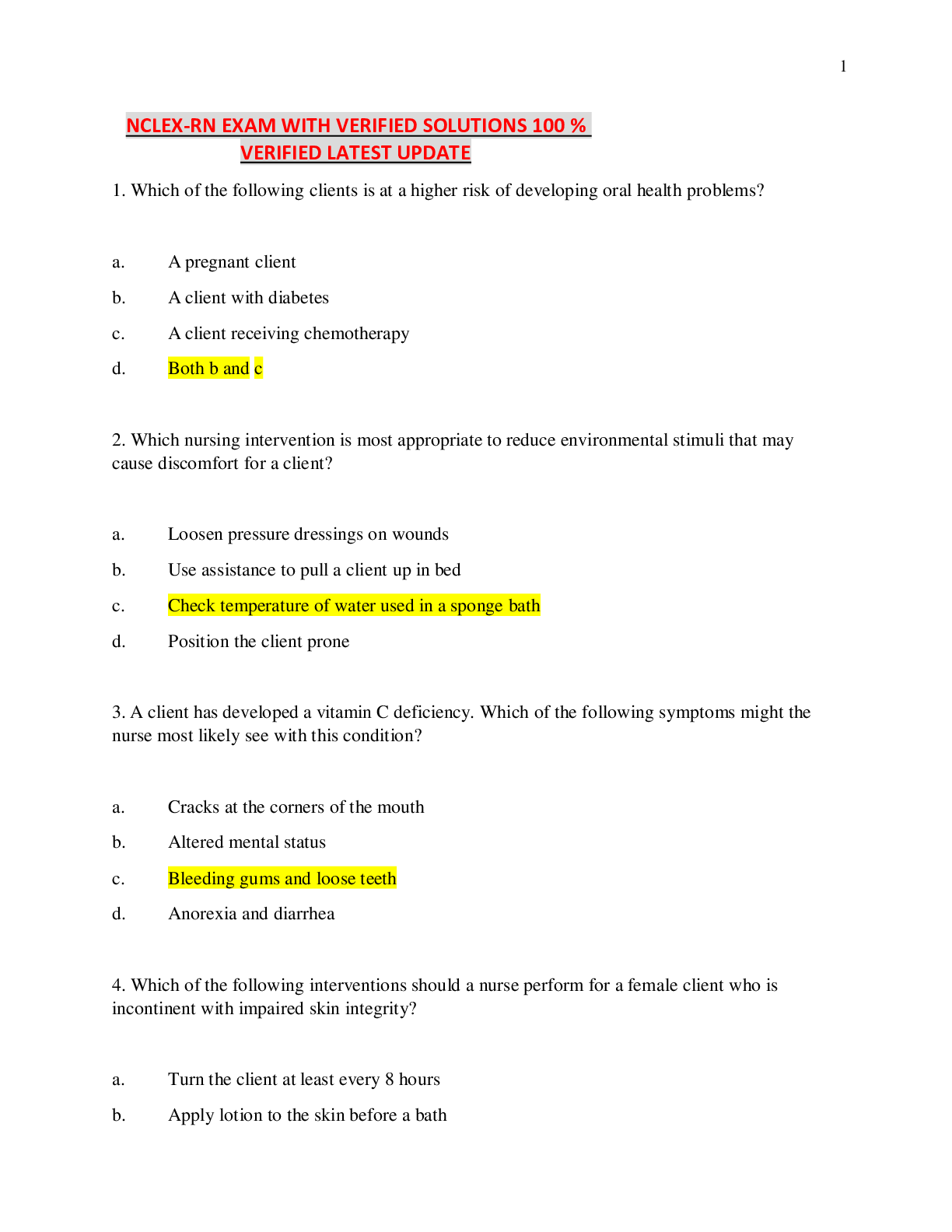*NURSING > NCLEX-RN > NCLEX Nursing Fundermentals Module 11 (2020) Questions and answers – Keiser University | NCLEX Nur (All)
NCLEX Nursing Fundermentals Module 11 (2020) Questions and answers – Keiser University | NCLEX Nursing Fundermentals Module 11 (2020) Questions and answers
Document Content and Description Below
NCLEX Nursing Fundermentals Module 11 (2020) Questions and answers – Keiser University 1.Which atrioventricular heart block is also referred to as Mobitz II A. Third-degree atrioventricular heart... block B. Second-degree atrioventricular heart block C. First-degree atrioventricular heart block D. Complete heart block Third-degree atrioventricular heart block is also referred to as Mobitz II; this type of heart block occurs when the AV node impulses are blocked as they try to reach the ventricles. First degree heart block occurs when the AV node impulse is delayed. Second degree heart block, as referred to as Mobitz I and Wenckebach, occurs when there are progressive conduction delays through the AV node that alters the PR and QRS intervals. Complete heart block blocks all atrial impulses to the ventricle. 2. Which preventive measure can be employed to decrease the risk of compartment syndrome? A. The administration of a potassium sparing diuretic for heart failure B. A bivalve cast for a skeletal fracture C. A cerebral diuretic to decease intracranial pressure after a head injury D. A chest tube to restore normal intrathoracic pressure after a pneumothorax A bivalve cast, rather than a solid fiberglass or plaster of Paris cast, for a skeletal fracture can prevent limb threatening compartment syndrome. Compartment syndrome results from increased pressure and circulatory constriction because a solid cast does not accommodate post fracture swelling like a bivalve cast does. Compartment syndrome is not related to heart failure, head injuries or pneumothoraxes. 3. Which patient is at greatest risk for papilledema? A. An elderly patient with cataracts and macular degeneration B. A male patient with hypothyroidism C. A male patient with hyperthyroidism D. An adolescent with a closed head injury Correct Response: D Patients, including adolescents, with a closed head injury is at greatest risk for papilledema because closed head injuries lead to an increase in intracranial pressure which leads to papilledema. Hyperthyroidism is associated with exophthalmos and there is no relationship or positive correlation of macular degeneration and/or cataracts to papilledema. 4. Your patient has been diagnosed with orchititis. What information about this disorder should you inform the patient about? A. This disorder often occurs as the result of a streptococcus. B. This disorder can be symptomatically treated with ice. C. This disorder can be symptomatically treated with heat. D. This disorder is typically treated with surgery. Correct Response: B The pain associated with orchiditis, an inflammation of the testicles, is symptomatically treated with the application of ice, not heat, to the groin area. It is not treated with surgery. This infection most often occurs as the result of mumps, the paramyxovirus and some sexually transmitted diseases, not streptococcus. 5. Which of the following healthcare providers can legally have access to all, or part, of a patient’s medical record because they have a “need to know”? Select all that apply. A. Student nurses caring for a particular patient B. Registered nurses when they are not caring for a particular patient C. The Vice President for Nursing who is investigating a patient fall D. Licensed practical nurses caring for a particular patient E. A quality assurance nurse collecting data for a performance improvement activity Correct Response: A,C,D,E Medical records are restricted to only those who have a “need to know”. Student nurses caring for a particular patient have the “need to know” so they can properly care for their patient assignment. The Vice President for Nursing, as an administrator, who is investigating a patient fall also has a “need to know” because they are collecting data and information to prevent future falls. Licensed practical nurses caring for a particular patient have the “need to know” so they can provide care to the patient; and the quality assurance nurse has the “need to know” because they are collecting data for a performance improvement activity. No nurse, including registered nurses, are allowed access to all or part of a patient’s medical record unless they have a “need to know” because they are providing either direct or indirect care to the patient. 6. Which cardiac arrhythmia can be either acquired or congenital and can spontaneously disappear on its own or lead to ventricular fibrillation? A. Wenckebach B. Premature arterial contractions C. Torsades de pointes D. Premature ventricular contractions Correct Response: C Torsades de pointes, a polymorphic ventricular tachycardia, can be either congenital or acquired; at times, it can spontaneously terminate but it frequently leads to ventricular fibrillation. In some cases cardiac death can occur with the first episode. All of the other cardiac arrhythmias, or dysrhythmias, are acquired and not congenital. 7. Which quality assurance or performance improvement technique is used to identify underlying process flaws? A. Small group process B. Root cause analysis C. People at fault process D. Cause and effect Root cause analysis is a quality assurance or performance improvement technique that is used to identify the underlying, root causes of a problem. Root cause analysis focuses on process flaws and NOT on people who have erred or made a mistake. A cause and effect diagram may be used for root cause analysis but it, in itself, is not a quality assurance or performance improvement technique. Although small groups participate in quality assurance or performance improvement activities, small groups are not a quality assurance or performance improvement technique. 8. Which legal document will most likely contain the patient’s decision to not get cardiopulmonary resuscitation? A. Healthcare surrogacy B. Healthcare proxy C. Advance directives D. Durable power of attorney Advance medical care directives, also referred to as living wills, contain the wishes of the client in terms of treatments and interventions that they do and do not want carried out when they are no longer able to competently provide these consents and rejections of treatment. These legal documents typically include choices relating to cardiopulmonary resuscitation (CPR), mechanical ventilation, intravenous solution administration, life support measures and tube feedings. A durable power of attorney for health care, also referred to as a healthcare surrogate or healthcare proxy, is a legally appointed person who will make decisions relating to healthcare when the client is no longer competent and able to give legal, informed consent. 9. Select the stage of a pressure ulcer that is accurately pair with its characteristics. A. Stage I: Only slight blanching when pressure is applied to the skin. B. Stage II: The epidermis and part of the dermis is damaged or lost. C. Stage III: The wound has slough and eschar. D. Stage IV: The loss of skin usually exposes some fat. A Stage II pressure ulcer damages the epidermis and part of the dermis. A Stage I pressure ulcer remains intact and the skin doesn't briefly lighten or blanch when touched. A Stage III pressure ulcer is a deep wound that can expose some fat; and a Stage IV pressure ulcer exposes bone, muscle and tendons. It is also characterized with slough and eschar. 10. You have been assigned to care for a neonate who has been diagnosed with the Tetralogy of Fallot. The mother asks you what the Tetralogy of Fallot is. How should you respond to this mother? A. “The Tetralogy of Fallot is a congenital gastrointestinal disorder” B. “The Tetralogy of Fallot is a congenital cardiac disorder” C. “The Tetralogy of Fallot will affect the baby’s reflexes” D. “The Tetralogy of Fallot will affect the baby’s ability to breastfeed” 11. The protrusion of an internal organ through a wound or surgical incision is referred to as: A. Serosanguineous. B. Dehiscence. C. Evisceration. D. Exuded. Evisceration, or the protrusion of an organ through a wound, most often occurs in the abdominal wall. Serosanguineous describes the thin, red exudate produced by a surgical wound and dehiscence is the separation of a surgical incision. Exuded is another name for discharged in reference to the exudate. 12. Which pain assessment scale is used exclusively for infants and neonates from 32 weeks of gestation to six months of age? A. The PEPPS pain scale B. The FLACC pain scale C. The Faces pain scale D. The CRIES pain scale The CRIES Pain scale is used exclusively for infants and neonates from 32 weeks of gestation to six months of age. This scale has five behavioral measurements that are scored from 0 to 2; the behavioral measurements include the infant’s crying, requirements for increased oxygen, increased vital signs, expression, and sleepiness. The PEPPS pain scale (Pre-Verbal, Early Verbal Pediatric Pain Scale is used to assess and measure pain among toddlers. The Face, Legs, Activity, Crying, Consolability Scale (FLACC) is used for infants over two months of age and children up to three years of age. The Faces Pain Scale contains cartoon like pictures of six faces ranging from 0, or “no hurt” to 10 which represents “the worst hurt”. It is used for pediatric patients who are three years of age and older. 13. Which of the following is a hazard of immobility? A. Loss of bone calcium B. Increased vital capacity C. Venous vasoconstriction D. A positive nitrogen balance One of the hazards of immobility is the loss of calcium from the bones that results from non weight bearing by the immobilized patient. Other complications, or hazards, of immobility include muscle weakness, muscular atrophy, contractures, disuse osteoporosis, hypostatic pneumonia, pooled respiratory secretions, atelectasis, decreased respiratory movement, decreased, not increased, vital capacity, shallow respirations, diminished cardiac reserve, orthostatic hypotension, venous stasis, venous vasodilation, not vasoconstriction, emboli, dependent edema, stiff and painful joints, thrombophlebitis, urinary stasis, renal stones, urinary retention, urinary incontinence, urinary tract infections, pressure ulcers, diminished metabolic rate, a negative, not positive, nitrogen balance, a negative calcium balance, constipation and depression. 14. How many daily feedings are considered normal for a newborn: A. 8 to 10 B. 10 to 12 C. 6 to 8 D. 12 to 14 An average newborn’s stomach empties every 1.5 hours, so common feeding times occur about every 2 hours during a 24 hour period; therefore, 10 to 12 feedings per day is typical. Frequent breastfeeds increase a mother’s prolactin levels, and high prolactin levels are required to establish an adequate milk supply. A higher-frequency of feedings help babies compensate for the lower caloric density of the milk. 15. The hormone produces mother’s milk is: A. Progesterone B. Estrogen. C. Prolactin. D. Colostrum. Prolactin is a protein that is best known for its role in enabling females to produce milk, but it also has other functions, such as regulating the immune system. Progesterone has many roles relating to the development of the fetus during pregnancy. Estrogens are best known for their importance in both menstrual and estrous reproductive cycles. Colostrum is the most nutrient dense part of breast milk produced during the postpartum stage. 16. Which of the following is a life threatening acute complication of diabetes mellitus? A. Neuropathy B. Hypoglycemia C. Retinopathy D. Impaired microcirculationHypoglycemia is an acute complication of diabetes which can be life threatening. The immediate treatment with glucose is necessary to preserve life. Retinopathy, neuropathy and impaired microcirculation are examples of the long term, rather than acute, complications of diabetes. 17. Sutures and staples are typically removed following surgery within: A. 7 to 10 days if healing is considered adequate. B. 10 to 14 days if healing is considered adequate. C. 7 to 10 days if no further dressings are needed. D. 10 to 14 days if no further dressings are needed. Sutures and staples can be removed within 7 to 10 days if healing has been sufficient and while this removal tends to reduce the amount of dressing supplies needed after removal, a light dressing may still be necessary. 18. Which of these breath sounds is considered normal and not adventitious? A. Vesicular breath sounds B. Fine rales C. Rhonchi D. Wheezes Vesicular breath sounds are normal breath sounds. Rales, fine and coarse, rhonchi and wheezes are all abnormal, adventitious breath sounds. 19. Which type of burn leads to the greatest degree of pain? A. A first degree burn B. A second degree burn C. A third degree burn D. A fourth degree burn Although the first degree burn can cause pain, it is the second degree burn that is the most painful of all. There is a lack of pain with third and fourth degree burns because these burns have destroyed pain sensory nerves. 20. Babies should double their birth weight by the: A. 5th to 6th month. B. 3rd to 4th month. C. 4th to 5th month. D. 5th to 7th month. Most babies should have doubled their birth weight by 6 months, but many may have doubled their birth weight by 5 months of age. Newborns gain about five to seven ounces per week for the first 3 to 4 months of life. By their first birthday, many babies have tripled their birth weight. 21. Which of the following is best for a client who has difficulty swallowing and chokes frequently? A. A liquid diet. B. Tilting the head back when swallowing. C. Tucking the chin in when swallowing. D. Following each bite with a drink of water. The client should tuck the chin when swallowing rather than tilting the head back. Thin fluids and liquids, like water, are thickened prior to drinking to prevent chocking. Tilting the head back is dangerous. 22. How long can women lactate for? A. Indefinitely B. 12 to 18 months C. 18 to 24 months D. 30 to 36 monthsCorrect Response: A A woman can lactate indefinitely; however, it puts them at risk of developing osteoporosis due to the calcium depletion from the bones and teeth. Letting the baby wean itself is ideal. Ideally, all babies should be exclusively breastfed for six months with the gradual introduction of solid foods while continuing to breastfeed. Most women in the United States stop breastfeeding following the twelfth month of life. 23. Which anatomic malformations are associated with the Tetralogy of Fallot? A. A sub-aortic septal defect, an overriding aorta, left ventricular hypertrophy, and right ventricular outflow B. A sub-aortic septal defect, an overriding aorta, right ventricular hypertrophy, and left ventricular outflow C. A sub-aortic septal defect, an overriding aorta, pulmonary atresia, and right ventricular outflow D. A sub-aortic septal defect, an overriding aorta, right ventricular hypertrophy, and right ventricular outflow Correct Response: D The Tetralogy of Fallot consists of a sub-aortic septal defect, an overriding aorta, right, not left, ventricular hypertrophy, and right, not left, ventricular outflow. Pulmonary atresia is not one of the anatomical malformations included in the Tetralogy of Fallot. 24. Your 32 year old female patient has erythema marginatum, Sydenham chorea, epistaxis, abdominal pain, fever, cardiac problems and skin nodules. What disorder would you most likely suspect based on these signs and symptoms? A. Leukemia B. Histoplasmosis C. Pneumocystis jirovec D. Rheumatoid arthritis Correct Response: D Erythema marginatum, Sydenham chorea, epistaxis, abdominal pain, fever, cardiac problems and skin nodules are the signs and symptoms of rheumatoid arthritis. Some of the signs and symptoms of leukemia are fever, bleeding and bruising, shortness of breath, loss of appetite, pain in the bones or stomach and painless lumps in the neck, groin and/or underarm. Histoplasmosis, a fungal infection, is characterized with fever, chills, cough, chest pain, joint pain, mouth sores and erythema modosum. Lastly, the signs and symptoms of Pneumocystis jirovec, among others, can include fever, shortness of breath, rapid breathing and a dry cough. 25. Select the cranial nerve that is accurately paired with its name. A. The first cranial nerve: The trochlear nerve B. The twelfth cranial nerve: The hypoglossal nerve C. The tenth cranial nerve: The olfactory nerve D. The thirteenth cranial nerve: The auditory nerve 26.Round off these numbers to the nearest hundredth. Fill in the blanks. A. 5.5778 = _5.58 B. 1.027 = __1.03 C. 62.999 = _63 _ D. 55.123 = _55.12 E. 96.679 = _96.68 Correct Response: A: 5.58 B: 1.03 C: 63 D: 55.12 E: 96.68 27. Label the following bones of the pelvis: Correct Response: A: Pelvis B: Sacrum C: Coccyx D: Symphysis Pubis Correct Response: A: Pelvis B: Sacrum C: Coccyx D: Symphysis Pubis 28. Round off these numbers to the nearest tenth: A. 5.5778 = _5.6 B. 1.027 = _ 1.0 C. 62.999 = _ 63 D. 55.123 = 55.1 E. 96.676 = 96.7 Correct Response: A: 5.6 B: 1 C: 63 D: 55.1 E: 96.7 29. The doctor has ordered 500 mg of a medication po once a day. The tablets on hand are labeled as 1 tablet = 30.250 mg. How many tablets will you administer to your patient? A. 1 Tablet B. 2 Tablets C. 3 Tablets D. 4 Tablets Correct Response: B This problem is set up and calculated as shown below. 500 mg: X tablets = 250 mg: 1 tablet Or as 500mg / X = 250mg / 1 tablet Then you criss cross multiply: 500 mg x 1 = 500 mg 250X = 500 mg X =500 ÷ 250 = 2 tablets 31. Which patient is exercising their right to autonomy in the context of patient rights? A. An 86 year old female who remains independent in terms of the activities of daily living. B. An unemancipated 16 year old who chooses to not have an intravenous line. C. A 32 year old who does not need the help of the nurse to bathe and groom themselves. D. A 99 year old who wants CPR despite the fact that the nurse and doctor do not think that it would be successful. 32. The mnemonic “PERLA” is useful for the assessment of the eyes. What does PERLA stand for? A. Pupils equally reactive to light and accommodation B. Patient eyes are equally recessed and responsive to light and acuity C. Patient eyes are equally responsive to light and acuity D. Pupils equally reactive to light and acuity Correct Response: A The mnemonic “PERLA” stands for pupils equally reactive to light and accommodation, not acuity. Visual acuity is tested with the Snellen Chart among adult patients. 33. You are performing a neurological assessment of your adolescent patient. The patient has the Moro reflex. How should you interpret this neurological assessment finding? A. It is normal among adolescents. B. It indicates that the patient has an intact peripheral nervous system. C. It indicates that the patient has an intact central nervous system. D. It is not a normal finding. Correct Response: D The Moro reflex is a primitive, childhood reflex that disappears long before adolescence and at about 3 months after birth. The Moro reflex is also referred to as the startle reflex. Other primitive, infant reflexes are the sucking, rooting, step, tonic neck, Galant, grasp and parachute reflexes. 34. Which patient is most at risk for Osgood-Schlatter disease? A. An elderly female who is hospitalized with a hip fracture and on bedrest B. A middle aged male patient who has been exposed to asbestos in the shipping industry C. An adolescent who is physically active and the captain of their soccer team D. An infant of low birth weight and a gestational age of 28 weeks Correct Response: C An adolescent who is physically active and the captain of their soccer team is at greatest risk for Osgood-Schlatter disease which results from the overuse of the knee and is characterized with patellar tendon inflammation. Other sports that can lead to this disease include running, basketball and gymnastics. Mesothelioma results from asbestos exposure. Lastly, immobility, low birth weight and low gestational age are not associated with Osgood-Schlatter disease. 35. Your client is adversely affected with fever, night sweats, occult hematuria, tenderness of the spleen and Osler’s nodes. What disorder would you most likely suspect? A. Tuberculosis B. AIDS/HIV C. Pericarditis D. EndocarditisCorrect Response: D The signs and symptoms of endocarditis are fever, night sweats, occult hematuria, gross hematuria, tenderness of the spleen, fatigue, edema and Osler’s nodes which are tender, red spots that can be seen under the skin of the fingers. 36. Your pediatric weighs 15.8 kg. How many pounds does this child weigh? A. 36 pounds B. 33.6 pounds C. 35 pounds D. 34.8 pounds Correct Response: D Since there are 2.2 pound in one kilogram, you calculate the weight in pounds by multiplying 2.2 by the kg weight as below. 15.8 kg x 2.2 = 34.8 pounds 37. An episiotomy is: A. A surgical incision of the perineum to prevent tearing during delivery. B. Releasing the red plug from the cervix just before crowning occurs. C. An incision in the abdomen with which the baby can be delivered through. D. The severance of the umbilical cord between mother and child. Correct Response: A An episiotomy is a surgical incision of the perineum and the posterior vaginal wall to quickly enlarge the opening for the baby to pass through; this incision prevents tearing during a vaginal delivery. The releasing of the red plug is known as the bloody show. The baby delivered through an incision in the abdomen is a Caesarian delivery. Umbilical severance or cutting and clamping of the cord both apply to the procedure of separating mother and child after childbirth. 38. How many calories per kilogram does an average full-term infant require when the infants is around 1-2 months old? A. 140 calories per kilogram per day B. 120 calories per kilogram per day C. 100 calories per kilogram per day D. 160 calories per kilogram per day Correct Response: B An average full-term newborn requires 120 calories per kilogram of weight each day to grow into a healthy child. For example, if a newborn weighs 4.55 kilograms, multiply 4.55 by 120. 546 calories would be what an infant should consume in one day. 39. What are the six levels of consciousness from the most to the least responsive level of consciousness. Number all six using 1 as the most conscious and 6 as the least conscious. A. Obtunded B. Confused C. Lethargic D. Comatose E. Stuporous F. Alert Correct Response: A: 4 B: 2 C: 3 D: 6 E: 5 F: 1 From the most to the least state of consciousness are alert, confused, lethargic, obtunded, stuporous and comatose. 40. Select the stage of shock that is accurately paired with its characteristic. A. The initial stage of shock: Hyperventilation occurs and the blood pH rises. B. The compensatory stage of shock: Hypoxia occurs and lactic acid rises. C. The progressive stage of shock: Histamine is released; fluid and proteins leak into surrounding tissues and the blood thickens. D. The refractory stage of shock: Potassium ions leak out, sodium ions build up and metabolic acidosis increases.Correct Response: C During the progressive stage of shock, histamine is released, fluid and proteins leak into surrounding tissues and the blood thickens. The initial stage of shock is marked with hypoxia and an increase in lactic acid; the compensatory stage of shock is characterized with hyperventilation and rises in the blood pH. The progressive stage of shock is also characterized with the leakage of potassium ions, the buildup of sodium ions and increasingly more severe metabolic acidosis. The refractory, or final, stage of shock becomes irreversible. 41. The doctor has ordered 1,000 cc of intravenous fluid every 8 hours. You will be using intravenous tubing that delivers 20 cc/drop. At what rate will you adjust the intravenous fluid flow? _____ gtts per minute. A. 38 gtts/min B. 42 gtts/min C. 50 gtts/min D. 40 gtts/min Correct Response: B 42 gtts/min This calculation is performed using several steps as below. 1000 cc = 125 cc/hr 8 125 x 20 = 125 = 41.6 or 42 gtts rounded off 60 3 42. During which stage of anesthesia is a patient most likely to experience involuntary motor activity? A. Stage I B. Stage II C. Stage III D. Stage VI Correct Response: B Stage II, commonly referred to as the excitement stage, is the stage of anesthesia when the patient is most likely to experience involuntary motor activity period; at this time, auditory and physical stimuli must be avoided to reduce the risk of increased tachycardia during this stage. Stage I is the administration phase, Stage III is the surgical phase, and Stage IV is the cessation phase. 43. Select all of the risk factors that are associated with deep vein thrombosis. A. The use of oral contraceptives B. Type B and O blood C. Rh negative blood D. Obesity E. Nulliparity F. Leukemia Correct Response: A,D The risk factors associated with deep vein thrombosis are oral contraceptive use, obesity, hormone replacement therapy, hypercoagulable states, old age, type A blood, multiparity, not nulliparity, and among clients who have had major surgery and/or prolonged immobility. Types B and O blood, Rh-negative blood and leukemia are not risk factors associated with deep vein thrombosis. 44. Most water leaves the body by way of the: A. Lungs. B. Intestines. C. Skin. D. Kidneys. Correct Response: D The kidneys, via urine, excrete approximately 60% of all water. Water, in lesser volumes, also leaves the body by way of lung expiration, skin perspiration, and through the intestines. 45. Which statement about glaucoma is true and accurate? A. Acute angle-closure glaucoma is an ocular emergency. B. Acute angle-closure glaucoma leads to the loss of peripheral vision and tunnel vision. C. Primary open-angle glaucoma leads to eye pain, nausea and vomiting, blurry vision and halos. D. Bubbles are implanted to protect the retina from the glaucoma. 46. A cavity containing pus surrounded by inflamed tissue is: A. Cellulitis. B. An abscess. C. Extravasation. D. An adhesion. Correct Response: B A cavity containing pus surrounded by inflamed tissue is an abscess. An abscess is typically formed as a result of suppuration in a localized infection. Cellulitis is an infection of the skin characterized by heat, pain, erythema, and edema. Extravasation is the passage, or escape of blood, serum, or lymph fluids into the tissues. A band of scar tissue that binds together two surfaces that are typically separated is an adhesion. 47. The doctor has ordered 20 cc an hour of normal saline intravenously for your pediatric patient. You will be using a pediatric intravenous tubing that delivers 60 cc per drop. How many drops per minute will you administer using this pediatric intravenous set? Fill in the blank.____ drops per minute. A. 30 drops per minute B. 25 drops per minute C. 20 drops per minute D. 22 drops per minute Correct Response: C You would adjust the intravenous fluid rate to deliver 20 drops of the normal saline every minute. This calculation is performed as below. 20 cc/hr = 60 cc per drop = 20 x 1 = 20 drops per minute 48. What does the mnemonic device ABCDE stand for? A. Allergy, bleeding, chemicals, dietary, environment B. Allergy, bleeding, cardio, diabetes, endocrine C. Allergy, bleeding, cardio, digestive, endocrine D. Allergy, bleeding, cortisone, diabetes, emboli Correct Response: D Allergy, bleeding, cortisone, diabetes, and emboli (ABCDE) is a mnemonic that is often used to readily remember some of the serious disorders and risks associated with the perioperative. Allergies to medicines or environment, bleeding tendencies, cortisone or steroid use, diabetes mellitus, and previous embolic events are some of these. Allergies to medicines or environment, bleeding tendencies, cortisone or steroid use, diabetes mellitus, and previous embolic events are some of these. 49. Which of the following assessment tools is used to determine the patients’ level of consciousness? A. The Snellen Scale B. The Norton Scale C. The Morse Scale D. The Glasgow Scale Correct Response: D The Glasgow Scale assesses for altered levels of consciousness. The Snellen chart, not scale, is used to assess and measure visual acuity; the Norton Scale assesses patients’ risk for skin breakdown; the Morse Scale assesses patients’ risk for falls. 50. Wilms’ tumor is a form of: A. Renal cancer. B. Liver cancer. C. Basal cell carcinoma. D. Brain cancer. Correct Response: AWilms’ tumor, although rare, is a type of renal cancer. People of all ages can be affected with it, however, it is most common among members of the pediatric population. The treatments for Wilms’ tumor include radiation therapy, chemotherapy and surgical removal. 51. You will be reinforcing teaching and instructing the patient. Which basic principle of teaching should you follow? A. Sequence the instruction from the least complex to the most complex. B. Assume that the patient knows little or nothing about the topic. C. Tell the patient to call their significant other so you can instruct them. D. Use medically oriented terms so the patient will be able to speak with the doctor. Correct Response: A You should sequence the instruction from the least complex to the most complex when reinforcing teaching and instructing the patient. For example, if you are instructing the patient about coughing and deep breathing, you should begin the instruction by demonstrating normal breathing, then deep breathing and finally combining deep breathing with coughing. You should not assume that the patient knows little or nothing about the topic, you should determine what they know. It is not necessary to have the patient call their significant other so you can instruct them; this is only necessary when the patient is not able to understand the instructions. Lastly, you should not use medically oriented terms and medical jargon, but instead, terms that the patient understands. 53. Your patient has a blood potassium level of 9.2 mEq/L. What intervention should you anticipate for this patient? A. Intravenous potassium supplementation B. Intravenous calcium supplementation C. Kidney dialysis D. Parenteral nutrition Correct Response: C The normal potassium level is 3.7 to 5.2 mEq/L. A patient with a blood potassium level of 9.2 mEq/L is affected with severe hyperkalemia which can be life threatening. Medications, such as Kayexalate, are administered to rid the body of excessive potassium and emergency kidney dialysis may also be done to prevent life threatening cardiac arryhythmia and death. Potassium supplementation is used with hypokalemia and not hyperkalemia; calcium supplementation and parenteral nutrition have no therapeutic effects for the treatment of hyperkalemia. 54. Which of the following foods enhances the absorption of an iron supplement? A. Orange juice B. Green beans C. Fortified Milk D. Baked potato Correct Response: A Vitamin C aids in the absorption of iron, and orange juice is a reliable source of Vitamin C. Green beans, milk, or baked potatoes do not support the absorption of iron; they do not contain the necessary vitamin C. 55. Select a myth or falsehood relating to pain, pain management and addiction. A. Addiction can be accurately predicted. B. Withdrawal, drug tolerance and physical dependence do not indicate addiction. C. Pain medications can be used with patients who have a substance abuse history. D. Addiction is signaled when the client employs deception and stockpiling. Correct Response: B Withdrawal, drug tolerance and physical dependence do not indicate addiction as many people believe. All the other statements are incorrect and myths relating to pain and pain management medications. 56. What is the expected date of delivery for the woman who has had their last menstrual period on April 20th? A. January 20th B. January 27th C. January 29th D. January 31st 57. Clumsiness, difficulty running, climbing, and riding a bicycle are some of the earliest signs and symptoms of: A. Duchennes’s muscular dystrophy B. Osteomyelitis C. Talipes or clubfoot D. Septic joint, suppurative arthritis Correct Response: A Clumsiness, difficulty running, climbing, and riding a bicycle are some of the earliest signs and symptoms of Duchenne’s muscular dystrophy. This disorder is a sex-linked inherited genetic skeletal muscle wasting disorder and it is the most severe and most common of all dystrophies. Osteomyelitis is an infection with the bone. Talipes is a deformity of the foot and ankle and it is physically discernible. Septic arthritis is an infection of a joint that will also show visible signs of its presence. 58. Which statement about adjuvant medications is true and accurate? A. Licensed practical nurses cannot administer adjuvant medications. B. Adjuvant medications are schedule 2 narcotics. C. Adjuvant medications are schedule 1 narcotics. D. Adjuvant medications can be purchased over the counter. Correct Response: D Adjuvant medications, used to increase the effects of the opioids and nonopioid medications. These medications include anxiolytics, anesthetics, anticonvulsants, nonsteroidal analgesic medications and topical local anesthetics. Some of these medications, like ibuprophen, are available over the counter and they act on pain by deadening the nerve endings in the skin. Invasive local anesthetics are also used for severe pain, as below. 59. Which nonpharmacological technique entails the use of electronic monitoring equipment while the patient controls basic bodily mechanisms? A. Meditation B. Visualization C. Biofeedback D. Chiropractic Correct Response: C Biofeedback is a nonpharmacological technique that entails the use of electronic monitoring equipment while the patient controls basic bodily mechanisms such as body temperature, sweating, heart rate, blood pressure, muscle tension and sweating. 60. Which of the following is considered normal for the neonate? A. Chest Circumference: 10 to 13 inches B. Length: 16 to 22 inches C. Weight: 1,500 to 4,000 g D. Head Circumference: 12.6 to 14.5 inches Correct Response: D The normal and expected parameters for the neonate in terms of head circumference is 12.6 to 14.5 inches. The other normal measurements are: Length: 18 to 22 inches (45 to 55 cm) Weight: 2,500 to 4,000 g Chest Circumference: 12 to 13 inches 61. Your patient has been diagnosed with giant cell arteritis. What medication will this patient most likely be given? A. High doses of aspirin B. High doses of prednisone C. Methotrexate D. Albuterol Correct Response: B Patients with giant cell arteritis are treated low dose aspirin and high-dose prednisone. Giant cell arteritis is an inflammatory condition that affects medium and large vessels, including the temporal artery and the carotid artery. Methotrexate is used for the treatment of rheumatoid arthritis, not arteritis; and albuterol is an inhaled medication that is used for the treatment of bronchitis and chronic obstructive pulmonary disease (COPD). 62. The wound irrigation process cleanses the wound and: A. Reduces the potential of pain in the wound region or area. B. Stops the spread of infection by way of magnifying the “clean” area. C. Pushes extravasated blood from a hematoma into nearby healthy tissue. D. Allows for the introduction of medications in solution form. Correct Response: D Of all the choices above, the only correct fact about wound irrigation is that it allows the application of medications in solution. Introducing prescribed medications in solution form can dramatically reduce infection risks and facilitating proper wound heal. Unfortunately, the irrigation process can greatly increase the pain in a wound area. Wound irrigation can reduce the spread of infection, but not by increasing the area cleaned. The complications resulting by a hematoma are reduced through wound irrigation and not by pushing into other tissue. 63. You are caring for a four year old female patient who was severely burned in a house fire. How would you determine the extent of this child’s burns? A. By using the Lund and Browder chart B. By using the Rule of Nines C. By using the Rule of Tens D. By using the Parkland Formula Correct Response: A The Lund & Browder burn chart is used to determine the extent of burns among the members of the pediatric population. Adults are assessed by using the Rule of Nines and not the Rule of Tens. Lastly the Parkland Formula is used to determine the fluid needs of burn patients and not to determine the extent of their burns. 64. Your client has a doctor’s order that reads “advance diet as tolerated”. This client has returned from the recovery room after an appendectomy and he states, “I am hungry”. What would you offer this client to consume? A. Cheese and crackers B. Apple sauce C. Chicken broth D. A peanut butter sandwich Correct Response: C Clear liquids are the most appropriate choice for any postoperative patient. If the client tolerates these choices well, the diet may proceed to full liquids. Eventually, solid foods will be added to his diet. 65. Idiopathic thrombocytopenia purpura is: A. Highly similar to disseminated intravascular coagulation (DIC). B. Caused by the over production of platelets. C. A bleeding disorder that is characterized with too few platelets. D. Treated with immune system boosting medications. Correct Response: C Idiopathic thrombocytopenia purpura is bleeding disorder that is characterized with too few platelets, not the over production of platelets. Disseminated intravascular coagulation (DIC) is characterized with blood coagulation and not bleeding. The treatments of idiopathic thrombocytopenia purpura can include immune system depressants, not stimulants, prednisone, high-dose gamma globulin and anti RhD therapy. 66. Select the type of skeletal fracture that is correctly paired with its description. A. A complete fracture: The fractured bone penetrates through the skin to the skin surface. B. A pathological fracture: A fracture that results from some physical trauma. C. A greenstick fracture: This bends but does not fracture the bone. D. An avulsion fracture: A fracture that pulls a part of the bone from the tendon or ligament Correct Response: D An avulsion fracture pulls a part of the fractured bone from the ligament or tendon. A complete fracture is one with which the whole cross section of the bone is fractured; a compound or opened fracture pierces through the skin; a pathological fracture results from an underlying disease or disorder not physical trauma or stressors. Lastly, a greenstick fracture is a skeletal bone fracture that affects only one side of the bone. 67. Select the criteria that is accurately paired with its indication of birth weight or gestational age. A. Low birth weight: The neonate’s weight is less than 1,500 g at the time of delivery. B. Appropriate for gestational age: The neonate’s weight ranges from the 10th to the 90th percentile. C. Large for gestational age: The neonate’s weight is above the 99th percentile. D. Small for gestational age: The neonate’s weight is below the 20th percentile. Correct Response: B It is considered appropriate for gestational age when the neonate’s weight ranges from the 10th to the 90th percentile. A low birth weight is less than 2,500 g at the time of delivery. Large for gestational age is indicated when the neonate’s weight is above the 90th percentile and when the neonate’s weight is below the 10th percentile, it is considered small for gestational age. 68. Diabetes insipidus is the result of: A. A diet high in sugar and carbohydrates. B. A complicated pregnancy. C. A disorder of the pancreas. D. A disorder of the pituitary gland. Correct Response: D Diabetes insipidus is the result of a pituitary gland disorder although it can also occur as the result of a brain infection or tumor as well as a closed head trauma that impacts on the pituitary gland. Diabetes insipidus is a lack of antidiuretic hormone secretion from the pituitary gland and the signs and symptoms include polyuria, polydipsia, hypernatremia and dehydration. 69. Which position will you place your patient in when they are demonstrating the signs and symptoms of hypovolemic shock? A. The Trendelenberg position B. The supine position C. The left lateral position D. The right lateral position Correct Response: A You would place your patient in the Trendelenberg position when they are experiencing the signs and symptoms of hypovolemic shock. This position places the legs of the patient higher than the head and it increases the return of the blood in the extremities back into the circulating blood, thus increasing blood volume and the blood pressure, in addition to other necessary emergency measures. The supine, left lateral and right lateral positions do not produce this effect. 70. The fine, down-like hairs on the newborn’s ears, shoulders, lower back, and/or forehead are known as: A. Vernix. B. Lanugo. C. Milia. D. Vibrissea. All questions came from NCLEX Saunder’s Study Guide Correct Response: B The fine, soft hair found on a newborn’s body is referred to as lanugo. Vernix is creamy substance that protects the skin, milia are the tiny white bumps found on the nose and cheeks, and vibrissea are the small hairs found in the nasal vestibule of the newborn. [Show More]
Last updated: 1 year ago
Preview 1 out of 19 pages
 Questions and answers – Keiser University.png)
Reviews( 0 )
Document information
Connected school, study & course
About the document
Uploaded On
Aug 15, 2020
Number of pages
19
Written in
Additional information
This document has been written for:
Uploaded
Aug 15, 2020
Downloads
0
Views
55


 - Florida International University.png)
 - Florida International University.png)
 - Florida International University.png)
 - Florida International University.png)

